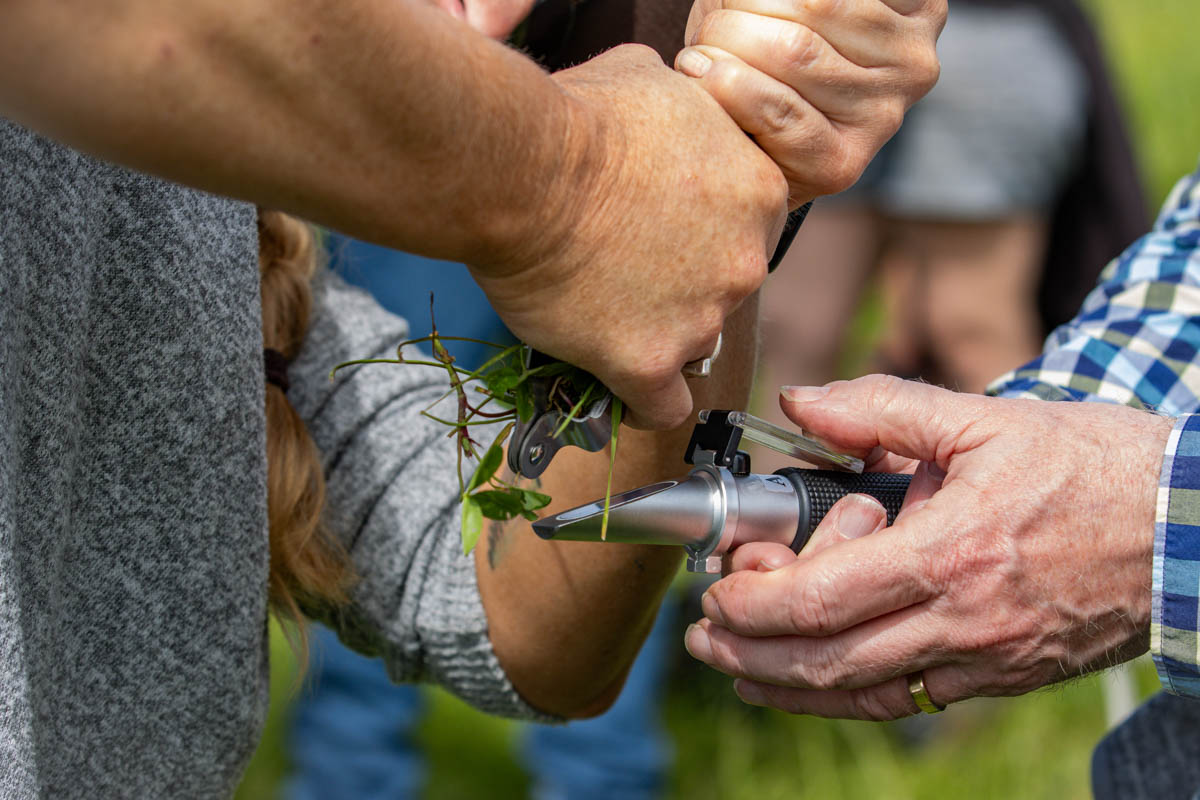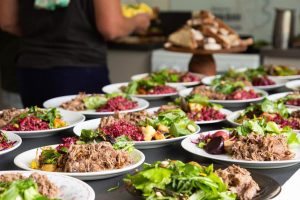Change Takes Time
The journey to organic dairy farming, building biodiversity, removing synthetic fertiliser and breathing life back into the soil does not happen overnight, but it starts by digging a hole.
Words Sheryl Haitana & Sarah Perriam-Lampp. Photos Camilla Rutherford, Sentient Imagery & Ella Bailey

Focussing on the soil beneath our cows’ feet to build healthy soils and build up organic matter is part of the Nestlé regenerative farming future under its Net Zero Roadmap.
The global food company has highlighted soils have suffered from “the over-application of herbicides and pesticides and the practice of mono-cropping” and is working with farmers on initiatives including crop rotation, mulching, organic fertilisers and minimising tillage.
The company is scaling up regenerative agriculture, aiming to improve soil health, sequester carbon, support food security, restore water resources and enable biodiversity.
“Organically ‘rich’ soils are more productive, maintain the integrity of land against soil erosion, retain more water and potentially store significant amounts of carbon.”
It is a farming principle that Neville and Louise Williams have been onboard with for 20 years. The couple’s farm is nestled on the lower foothills of Maungatautari Mountain, near Cambridge, in the Waikato Region.

The farm has Lely robotic machines and is fully certified organic, with an emphasis on regenerative agriculture.
Having farmed a high-input system previously, “the widespread pasture pulling was the motivator to first look at our soils,” Louise says. They switched gears to bring in more regenerative principles in their grass and soil management.
They no longer use chemical sprays, fertilisers or nitrogen. In recent times they have been using a lime and dolomite mix with sea minerals and trace elements in the autumn plus Biosea Organic Fert with beneficial biology in the spring.
The farm is planted in mixed pastures, through using minimal tillage and oversowing and undersowing, including plantain and chicory to suit long rotations and to be more resilient of drought conditions. “We are happy to say pasture pulling no longer worries us. The root depth has improved, but compaction is an ongoing issue to be worked on. We try to protect the soil by keeping it covered and avoiding pugging. We have many different plant species and slower rounds with the cows.”
The family recently hosted a two-day workshop hosted by Soil Sisters and Quorum Sense with star speaker Nicole Masters, who is known largely by her book For the Love of Soil.
To have Nicole onfarm digging holes, talking about their soil and spending time with other like minded farmers was a great opportunity, Louise says. “It was very motivating. I was reminded to dig more holes and test brix. Actually looking at the soil and plants is crucial.”
Nicole trained as an ecologist and soil scientist at Massey University. In 2006 she launched Integrity Soils, a company focused on training farmers, and advocated for New Zealand to seriously consider supporting regen-ag as a means of improving ecosystem function. At that time, however, few people within both the government and the agricultural sector were ready to hear her message, so she began to turn her energy offshore by 2015.
Nicole has spent the last five years developing an international reputation travelling in the US, Australia and Canada training farmers – speaking to thousands of farmers and ranchers at conferences, and advising governments on the opportunities to be gained by regenerating and maintaining healthy soils. Her consultancy work covers 29 million acres of farmland globally.
Nicole says New Zealand farmers are struggling with drought conditions because of their compacted soil rather than lack of rainfall. “When I talk to international audiences that NZ farmers are experiencing drought conditions, they are amazed that a temperate-zone country like NZ with comparatively high rainfall is in the middle of a drought.”
While farmers in Australia and the US experience drought due to a prolonged lack of rainfall, many of NZ’s drought woes stem from the fact the soil doesn’t retain enough moisture, Nicole says.
“NZ isn’t experiencing the distinct and obvious desertification that other regions of the world are facing due to climate change-driven droughts, but our issue is with the compaction of soil and the consequent high rates of run-off.”
Nicole attributes this compaction to shallow rooting plants and poor biological functioning of the soil due to the liberal application of soluble fertilisers. “We have pretty good organic matter compared to other countries, but we’ve just got more of a buffer that I think has made us a little bit more complacent. And that complacency, potentially, could cost people.”
Nicole explains that we have a whole tool belt in the field of building soil health with an ecological lens by addressing things that are the root cause instead of chasing symptoms which she believes makes ‘reactive agriculture’ so costly.
Nicole says New Zealand farmers are struggling with drought conditions because of their compacted soil rather than lack of rainfall.
“Most of the negative farming practices such as overgrazing, overuse of pesticides and fungicides, heavy fertiliser application and compaction undermine the most beneficial organisms on the planet – fungi. They take and draw water deeper down in the profiles. We think about drought resilience, it’s all about fungus holding the soil together. By simulating microbiology we build that soil structure, your gas exchange now works, your water cycle is working, the nutrient cycles are working. And that all starts just by digging a hole,” explains Nicole.
Farmers themselves will be key to driving change toward more sustainable farming. “Anyone with an interest in agricultural extension knows that there is a huge amount of evidence to support the fact that it is the farmers who are the innovators, who discover new methods to solve onfarm issues, whilst science then provides the data to support their findings,” Nicole says.
Planting for the future
It takes time to turn your system around from years of conventional methods, Louise says.
“It takes time to change systems, to wean off the chemicals and give the land and animals time to adjust and thrive under a different regime.
“We’re wanting to show that farming can be good for the people and the land, water and animals. We are looking to ensure the farm is in great shape for future generations. We are excited about the opportunities in agriculture.”
The farm has lowered its stocking rate by 20% in the past eight years, whilst holding total production through a strong focus on breeding more efficient cows, with only an 8.7% empty rate this season and 5.6% the year before.
The herd has a high degree of natural immunity built up and live a stress free life coming in to get milked when they choose. The information collected from the robotic milkers is used to proactively manage animal health.

The low input farm system and robotics helps to reduce staff requirement and to keep farm working expenses low.
The Williams family have planted thousands of trees on the farm over the past 40 years. They have had a farm scoping study and restoration plans from an ecologist which has included retiring steep and wet areas to reduce runoff and erosion. They now have 15ha plus planted in natives, some of which has been done in partnership with the Waikato River Authority.
The plantings are helping to create a bird corridor from Maungatautari Mountain to the Waikato River. They are currently working on transforming a pine block into native with some funding from Trees That Count. They collect seeds from previous plantings and have grown more than 10,000 plants for this latest project.
They also have predator traps onfarm and have joined the Bush to Burbs project.
Louise feels they have a healthy resilient system in place to face the challenges of today’s dairy farming environment.
Eighty people attended the two-day workshop, from across the dairy, horticulture, market gardening and sheep and beef industry, including representatives from DairyNZ and Fonterra.
Waikato dairy farmer James Dallinger attended the Nicole Masters workshop and said farmers are asking more questions when it comes to soil health. “Farming is a tough gig and we are time poor, but access to information online – through podcasts, audiobooks – and hearing the voices of those like Nicole, people are increasingly starting to ask the toddler questions “why, why, why?”
Despite all the years of science and research there is still so much to learn about what’s beneath our feet, he says. “Unfortunately there is no “silver bullet” or “one size fits all” approach, and that more often than not, less is more. I’m still blown away at the small trial grids with different foliar applications, and how small amounts raised the brix reading the most yet we would pile mountains of fertiliser or supplementary feed to try to get a similar result.”
Farmers are most of the way there, and only subtle changes need to be made in most instances, he believes. “I think every farmer out there is doing their absolute best with the knowledge they have at this present time to make the best decisions they can on the day.
“I see the potential in reducing input costs, growing more home grown tucker, and possibly even becoming more drought proof/tolerant or prepared. And the possibility of being less reliant on imported feed.
“Perhaps this is even an opportunity to help products from New Zealand have an even bigger point of difference within the global markets.”
Manawatu farmer Russell Heald also attended the workshop. Russell milks 350 cows on 170Ha at Norsewood. The farm has been a Fonterra organic regen system for seven years. “My biggest takeaway was understanding that less is more with a lot of things we do onfarm, and if you are curious about something ask the questions.”
There are opportunities for farmers around increasing water infiltration rate and water holding capacity to build resilience in their farming operations, he says.
Key Facts
Farm Business: Our Land of Milk and Honey
Farm owners: Neville and Louise Williams
Location: Horahora, Waikato
Area: 160 ha, 110ha effective milking platform. 30ha for young stock, 20ha retired
Cows: 285 crossbreeds, 50 rising 2yr, 50 rising 1yr.
Operation: Organic, DairyNZ System 2
Farm Dairy: Four Lely Robotic automatic milking systems
Pasture: 12t DM/ha harvested, nil urea, pasture as percentage of feed consumed: 98%
Supplement: 550 silage bales bought in or made from farm surplus
Greenhouse Gas Emissions: 10.6 kgCO2e/kgMS
Purchased Nitrogen Surplus: -58kg N/ha
You can follow Neville and Louise’s journey via Instagram @_OLMH






